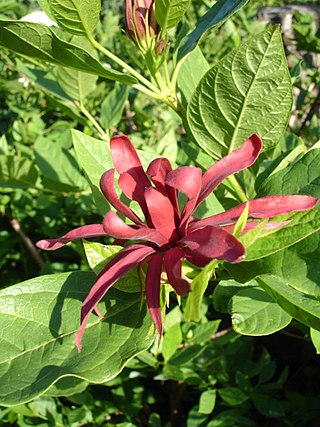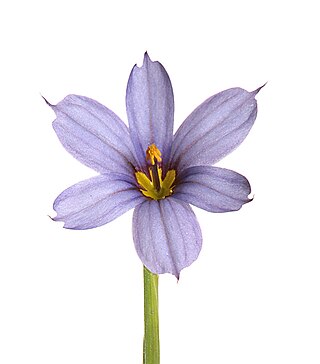
Royal Botanic Gardens, Kew is a non-departmental public body in the United Kingdom sponsored by the Department for Environment, Food and Rural Affairs. An internationally important botanical research and education institution, it employs 1,100 staff. Its board of trustees is chaired by Dame Amelia Fawcett.

Persicaria maculosa is an annual plant in the buckwheat family, Polygonaceae. Common names include lady's thumb, spotted lady's thumb, Jesusplant, and redshank. It is widespread across Eurasia from Iceland south to Portugal and east to Japan. It is also present as an introduced and invasive species in North America, where it was first noted in the Great Lakes region in 1843 and has now spread through most of the continent.

The Australian National Botanic Gardens (ANBG) is a heritage-listed botanical garden located in Acton, Canberra, in the Australian Capital Territory, Australia. Established in 1949, the Gardens is administered by the Australian Government's Department of Agriculture, Water and the Environment. The botanic gardens was added to the Commonwealth Heritage List on 22 June 2004.

Calycanthus, called sweetshrub, is a genus of flowering plants in the family Calycanthaceae. The genus includes two to four species depending on taxonomic interpretation; three are accepted by most 21st century sources.
The New Mexico State University Agricultural Experiment Station is a system of scientists who work on facilities on the main campus in Las Cruces and at 12 agricultural science and research centers located throughout the state of New Mexico. It facilitates and administers the botanical gardens, the NMCR herbarium, and other agricultural facilities associated with New Mexico State University.

Andropogon is a widespread genus of plants in the grass family, native to much of Asia, Africa, and the Americas, as well as Southern Europe and various oceanic islands.

Elmer Drew Merrill was an American botanist and taxonomist. He spent more than twenty years in the Philippines where he became a recognized authority on the flora of the Asia-Pacific region. Through the course of his career he authored nearly 500 publications, described approximately 3,000 new plant species, and amassed over one million herbarium specimens. In addition to his scientific work he was an accomplished administrator, college dean, university professor and editor of scientific journals.

Bothriochloa is a common and widespread genus of plants in the grass family native to many countries on all inhabited continents and many islands. They are often called beardgrass, bluegrass or bluestem.

Sporobolus is a nearly cosmopolitan genus of plants in the grass family. The name Sporobolus means "seed-thrower", and is derived from Ancient Greek word σπόρος (spóros), meaning "seed", and the root of βάλλειν (bállein) "to throw", referring to the dispersion of seeds. Members of the genus are usually called dropseeds or sacaton grasses. They are typical prairie and savanna plants, occurring in other types of open habitat in warmer climates. At least one species is threatened with extinction, and another is extinct.

Sisyrinchium montanum, the blue-eyed-grass, American blue-eyed-grass, or strict blue-eyed grass, is a grass-like species of plant from the genus Sisyrinchium, native to northern North America from Newfoundland west to easternmost Alaska, and south to Pennsylvania in the east, and to New Mexico in the Rocky Mountains. It has also been introduced to parts of France, likely during the First World War.

Sisyrinchium angustifolium, commonly known as narrow-leaf blue-eyed-grass, is a herbaceous perennial growing from rhizomes, native to moist meadow and open woodland. It is the most common blue-eyed grass of the eastern United States, and is also cultivated as an ornamental.

Sporobolus virginicus, known by numerous common names including seashore dropseed, marine couch, sand couch, salt couch grass, saltwater couch, coastal rat-tail grass, and nioaka, is a species of grass with a wide distribution.

Erodium cygnorum is a species of herb native to Australia.

Phalaris minor is a species of grass native to North Africa, Europe, and South Asia. The bunchgrass is widely naturalised elsewhere.

Potamophila is a genus of Australian plants in the grass family.

Bothriochloa ischaemum is a species of perennial grass in the family Poaceae, found throughout much of the world. It is commonly known as yellow bluestem. Two varieties are recognized, of which Bothriochloa ischaemum var. ischaemum is native to Europe, Asia, and Africa and naturalized elsewhere, and var. songarica is native to Asia and naturalized elsewhere. Var. songarica is an invasive weed in Texas, where it is known as "King Ranch bluestem"; it has displaced native grasses in large areas of central and south Texas.

Bothriochloa bladhii is a Neotropic grass in the family Poaceae, found primarily in tropical Africa, and tropical and temperate Asia, and Australia. The type specimen was collected from China by Finnish botanist Peter Johan Bladh. The name of Bladh is honored in the specific epithet.

Bothriochloa pertusa is a species of grass. It is widely used as a fodder and a graze for livestock.

The National Herbarium of New South Wales was established in 1853. The Herbarium has a collection of more than 1.4 million plant specimens, making it the second largest collection of pressed, dried plant specimens in Australia, including scientific and historically significant collections and samples of Australian flora gathered by Joseph Banks and Daniel Solander during the voyage of HMS Endeavour in 1770.
Holcus annuus, called annual fog, is a species of flowering plant in the grass family Poaceae, native to the Mediterranean region and the Transcaucasus, and introduced to southeastern Australia. In spite of its scientific and common names, it is a perennial.


















